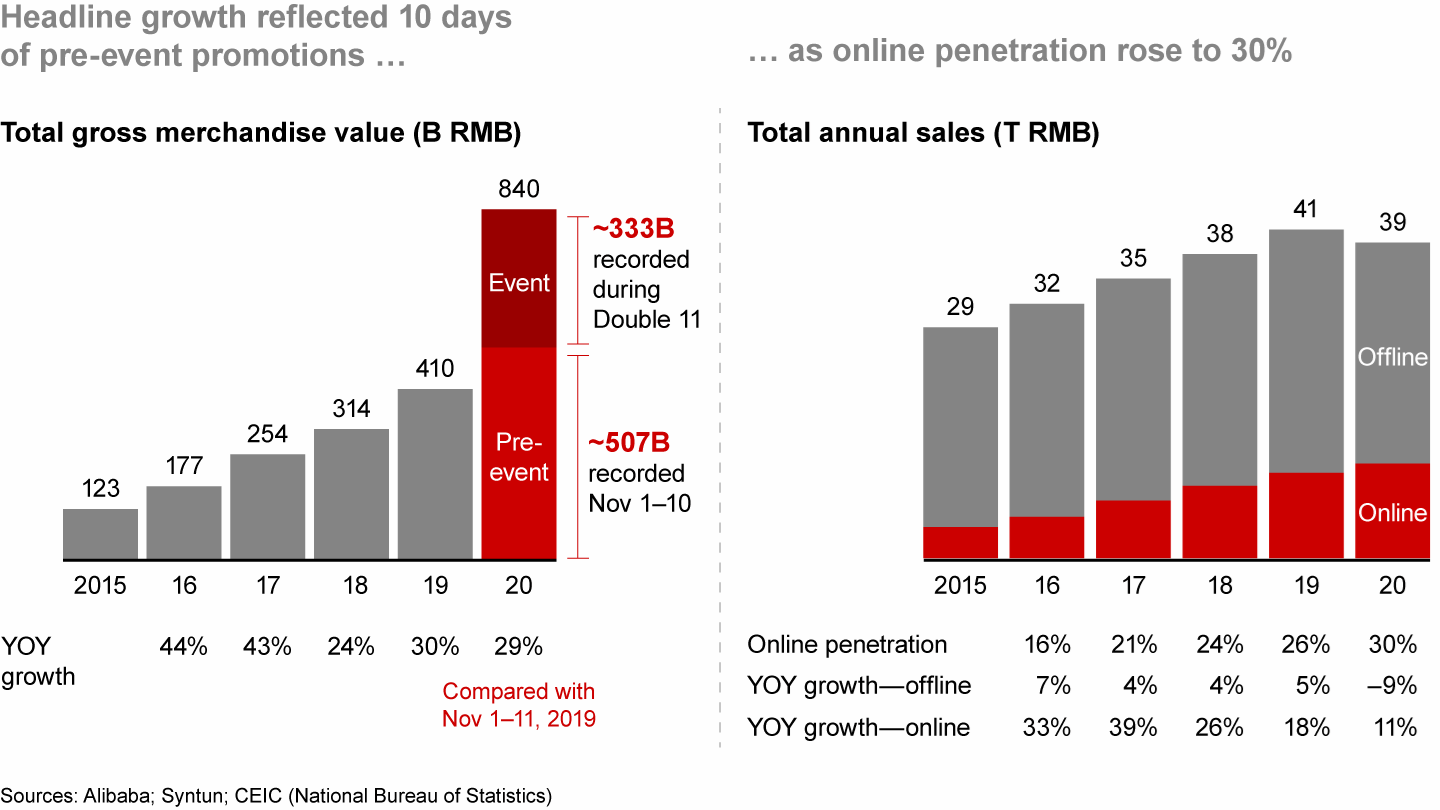Originally published by Bain and Company. Written by James Yang, Jonathan Cheng, and Melanie Sanders.
Prioritizing customer loyalty can rebalance growth during the world’s biggest shopping festival (and beyond).
At a Glance
· In Bain’s second Retail Holiday Newsletter of 2021, we turn to China, where retailers are used to posting big increases in headline sales from Singles Day on November 11. But the rules of the game are changing as the event (and e-commerce itself) matures.
· Although our survey of Singles Day shoppers suggests a continuation of some growth trends this year, competition for share of wallet is rising, and customer acquisition is set to get harder.
· Faced with this evolving dynamic, the most successful retailers will find ways to foster deep consumer loyalty that can outlast the benefits of undifferentiated discounting.
For tens of millions of consumers, it’s easy to say what success looks like on Singles Day, the annual Chinese shopping festival that dwarfs all other retail events on earth. Winning for them means getting a substantial discount on phones, TVs, clothing, cosmetics, vacations, and a multitude of other goods and services.
For retailers, it used to be just as simple to define success on Singles Day, also known as Double 11 because it falls on November 11. They only had to point to ever-increasing sales on their platform and across the industry, using gross merchandise value (GMV) as the headline revenue metric. Between 2014 and 2019, as more shoppers participated, the compound annual growth in Singles Day GMV for the overall retail sector was 35%.
Now, it’s not so straightforward for retail executive teams. Twelve years after it evolved from a celebration of unmarried status into a sales event on a single e-commerce platform, Singles Day is so big that opportunities for GMV growth are starting to dwindle. Most shoppers in Tier 1 and Tier 2 cities are already buying their fill. Even in lower-tier cities, there aren’t that many shoppers left to recruit, and their pockets aren’t as deep; sales growth there is going to be doubly challenging.
The business environment has also shifted to favor sustainable growth and profitability, not a win-at-all-costs obsession with the top line. That’s partly self-generated, a maturing of strategic priorities after stratospheric expansion, but it also reflects a steep drop in stock market valuations. For instance, the enterprise value-to-sales multiple of four leading e-commerce players fell 39% in the first half of 2021 amid high-profile regulatory moves (see Figure 1).
Figure 1
The stock market valuations of leading online retailers declined sharply in the first half of 2021 despite strong revenue growth

Against this backdrop, the strategic path for retailers would seem clear: Ease up on the Double 11 discounting and boost margins. There’s just one problem: Shoppers aren’t ready to give up their deals.
When we recently surveyed shoppers about their Singles Day 2021 expectations, almost 80% of respondents said they were hoping for a lot more discounts than in last year’s event. Retailers can’t turn their backs on these consumer demands and stay relevant. But discounting alone won’t allow them to win under the new rules of the game.
There is a solution to this dilemma, however. While GMV remains an important measure, retailers have an opportunity to reach for a new definition of Singles Day success, one that’s anchored in customer loyalty as well as customer acquisition. By prioritizing other metrics such as customer lifetime value and Net Promoter ScoreSM, executive teams can start building a more sustainable and defensible proposition for the long term. We think this shift will help them win throughout the year, not just on the biggest day in the global retail calendar.
Key trends for Singles Day 2021
Even though retailers posted strong GMV gains for Singles Day in 2020, the headlines don’t tell the full story. GMV was RMB 840 billion, more than double the RMB 410 billion posted in the pre-pandemic 2019 festival (see Figure 2). Yet this increase was boosted by 10 days of pre-event promotions. When we adjusted for this and compared 2020’s performance with the GMV for November 1–11, 2019, the year-over-year increase was 29%.
Figure 2
Singles Day was bigger but also longer in 2020, while e-commerce hit a milestone amid the pandemic

To get a picture of trends for Singles Day this year, we worked with technology company Toluna to survey 3,000 consumers who took part in Double 11 last year, spread across a wide range of Chinese cities. Almost everybody (95%) said they intended to take part in the event again in 2021, and most (76%) said they were very excited about it. Slightly more than half (52%) said they were planning to spend more than last year, when the average spending per customer was RMB 2,104, while only 8% said they were planning to decrease their spending. Women were more likely than men to be anticipating a bigger outlay during the festival in 2021.
Some key trends that fueled GMV growth last year appear to be continuing. For instance, penetration in lower-tier cities is likely to increase again and breach a symbolic threshold: Our consumer survey suggested that there will be more first-time Double 11 participants from Tier 3, 4, and 5 cities this year than from Tier 1 and 2 cities. A pandemic-related surge in spending on wellness categories is also likely to carry over from 2020 to 2021, especially in cosmetics and personal care (see Figure 3). Overall, many Singles Day shoppers say they still strongly prefer brands that are familiar (more than 70% of respondents) and those that are value oriented (60%).
Figure 3
Singles Day shoppers expect to spend more across categories in 2021, with cosmetics and personal care set to shine

However, competition for share of wallet has long been intensifying on Singles Day. Over recent years, sales have been increasingly split between a growing number of platforms, as other retailers joined the event’s originator, the Alibaba-owned Tmall, in pushing the shopping festival to fresh heights. Shoppers continue to embrace this fragmentation. More than 50% of consumers in our survey said that they were planning to shop on three or more platforms during Double 11 this year.
If that last insight suggests many shoppers view retailers as interchangeable on Singles Day, it’s because they do. For many consumers, Double 11 discounting hasn’t fostered loyalty to a single platform; spoiled for choice, they prefer to shop around. But that doesn’t hold for all. Retailers that dig deeper are likely to find a hard core of users that count as genuine fans. These customers can be the bedrock of renewed strategic differentiation: Our survey suggests that a retailer’s Singles Day promoters tend to keep spending heavily throughout the year on that same platform (see Figure 4).
Figure 4
A retailer’s Singles Day promoters are more likely to spend freely with it during the rest of the year than shoppers who aren’t fans

The intensifying fight for loyalty
There’s no getting away from the fact that price remains vitally important, even among the hard core of fans that retailers need to target. As we mentioned at the start of this brief, the taste for deep discounts is unlikely to change soon, complicating efforts to improve margins. Yet some leading retailers have already made progress cultivating advocacy among their Singles Day customers that goes beyond a superficial “we like your deals” endorsement, pointing the way to more sustainable differentiation.
For instance, Alibaba continues to innovate and invest to enhance the customer experience, with loyalty to the fore. That’s partly through building up the attractiveness of its loyalty program, 88VIP, offering members benefits pulled from across the Alibaba ecosystem, such as free access to video streaming on Youku, discounts on food delivery through Ele.me, and cash-back vouchers for the online travel platform Fliggy.
Less obviously, Alibaba’s close cooperation with brands and manufacturers is also a loyalty lever. Brands get masses of data from Alibaba and digital tools to make sense of it, creating a better shopping experience that binds customers more tightly to the platform. Likewise, manufacturers get data about Alibaba shoppers that allows them to know exactly what consumers want, and tailor products accordingly. The loyalty benefit is twofold: Alibaba shoppers see more products that they want on the platform, and the products become more differentiated from the offerings of rival platforms.
JD.com has emerged as a Singles Day loyalty leader too. Its most enthusiastic customers consistently highlight its strong aftersales support. For instance, shoppers benefit from a 30-day price guarantee, a 180-day exchange window, and installation services. In addition, AI tools and other technological innovations have made its customer service more efficient. JD’s promoters also cited its prompt and reliable delivery—a result of sustained (and hard-to-replicate) investment in fully owned logistics capabilities.
It’s worth considering another loyalty leader that doesn’t tend to play such a prominent part in Singles Day promotions: Sam’s Club. The Walmart unit continues to set itself apart through a relentless focus on giving value to a core group of customers, which generates a profitable stream of membership fees. That’s far from being a niche business: There are now more than 3 million Sam’s Club members. What keeps them loyal? One thing is the quality of the products, including a thriving private-label range. Other hooks include enhanced perks for premium members, such as car washing, dental care, and eye exams. That kind of differentiated value has year-round appeal.
Strategic questions for Singles Day 2021 and beyond
Retail in China is approaching a point at which there can be no growth strategy without a loyalty strategy. Leaders in this new phase will rely on a broader range of metrics than GMV, monthly average users, and average revenue per user. They’ll also judge themselves against benchmarks such as NPS®, customer retention, operating profit, and customer lifetime value. Instead of over-indexing on Singles Day, they’ll invest in winning during a broader spread of events across the year.
To accelerate their transition to a loyalty-led model, executive teams might find it helpful to consider three groups of questions that venture well beyond November 11:
· How much does our approach to Singles Day feed into the bigger picture? Do our Double 11 deals target our most valuable customers? How is our Singles Day proposition evolving beyond functional elements to generate loyalty?
· Are we truly putting loyalty at the heart of what we do? Do we measure and track customer lifetime value systematically? How well do we know our most valuable customers and how they interact with us? How satisfied are our customers across key touchpoints?
· Are we reshaping the business to dial up differentiation and ease reliance on promotions? Is investment targeted to the most valuable customers? Will it deliver a year-round benefit, not just during sales festivals?
Retailers that reflect and then act upon these questions are likely to enter Singles Day 2022 in an even stronger position.
About the research
Data powered by Toluna, a global technology company delivering real-time insights with innovative technologies and global research expertise via the Toluna Start platform, integrated with a social voting network of more than 48 million consumers in 70-plus countries.
Net Promoter®, NPS®, and the NPS-related emoticons are registered trademarks of Bain & Company, Inc., Satmetrix Systems, Inc., and Fred Reichheld. Net Promoter Score℠ and Net Promoter System℠ are service marks of Bain & Company, Inc., Satmetrix Systems, Inc., and Fred Reichheld.



 Back to Blog
Back to Blog





